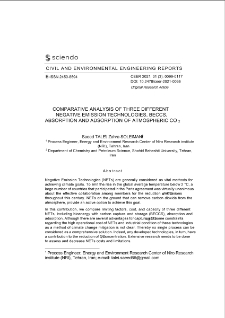Zielonogórska Biblioteka Cyfrowa udostępnia 65 391 obiektów cyfrowych
Obiekt
Tytuł: Comparative Analysis of Three Different Negative Emission Technologies: BECCS, Absorption and Adsorption of Atmospheric CO2
Współtwórca:
Tytuł publikacji grupowej:
Abstract:
Negative Emission Technologies (NETs) are generally considered as vital methods for achieving climate goals. To limit the rise in the global average temperature below 2°C, a large number of countries that participated in the Paris agreement was virtually unanimous about the effective collaboration among members for the reduction of CO2 emissions throughout this century. ; NETs on the ground that can remove carbon dioxide from the atmosphere, provide an active option to achieve this goal. In this contribution, we compare limiting factors, cost, and capacity of three different NETs, including bioenergy with carbon capture and storage (BECCS), absorption and adsorption. Although there are several advantages for capturing CO2, still some constraints regarding the high operational cost of NETs and industrial condition of these technologies as a method of climate change mitigation is not clear. ; Thereby no single process can be considered as a comprehensive solution. Indeed, any developed technologies, in turn, have a contribution to the reduction of CO2 concentration. Extensive research needs to be done to assess and decrease NETs costs and limitations.
Opis:
tytuł dodatkowy: Prace z Inżynierii Lądowej i Środowiska
Wydawca:
Zielona Góra: Oficyna Wydawnicza Uniwersytetu Zielonogórskiego
Format:
Identyfikator zasobu:
DOI:
Strony:
Źródło:
Civil and Environmental Engineering Reports (CEER), no 31, vol. 3
Jezyk:
Licencja CC BY-NC-ND 3.0:
Prawa do dysponowania publikacją:
Biblioteka Uniwersytetu Zielonogórskiego
Kolekcje, do których przypisany jest obiekt:
- Zielonogórska Biblioteka Cyfrowa > Repozytorium > Jednostki organizacyjne > Wydział Budownictwa, Architektury i Inżynierii Środowiska
- Zielonogórska Biblioteka Cyfrowa > Repozytorium > Typy utworów > Artykuły
- Zielonogórska Biblioteka Cyfrowa > Repozytorium > Czasopisma naukowe i serie wydawnicze UZ > Civil and Environmental Engineering Reports (CEER) > Civil and Environmental Engineering Reports (CEER) (2021)
Data ostatniej modyfikacji:
6 lip 2023
Data dodania obiektu:
27 mar 2023
Liczba wyświetleń treści obiektu:
155
Wszystkie dostępne wersje tego obiektu:
https://zbc.uz.zgora.pl/publication/79753
Wyświetl opis w formacie RDF:
Wyświetl opis w formacie OAI-PMH:
Obiekty Podobne
Błaszczyński, Tomasz Król, Maciej R. Kuczyński, Tadeusz - red.
Antczak-Jarząbska, Romana Krzaczek, Marek Kuczyński, Tadeusz - red.
Śmietanka, Tomasz Kuczyński, Tadeusz - red.
Djebien, Rachid Abbas, Yassine Bouabaz, Amel Ziada, Yasser Nacereddine Kuczyński, Tadeusz - red.
Myszograj, Sylwia Płuciennik-Koropczuk, Ewelina Kuczyński, Tadeusz - red.
Staszczuk, Anna Kuczyński, Tadeusz Kuczyński, Tadeusz - red.
Dali, Naouel Kuczyński, Tadeusz - red.
Włodarczyk-Makuła, Maria Greinert, Andrzej - red.

